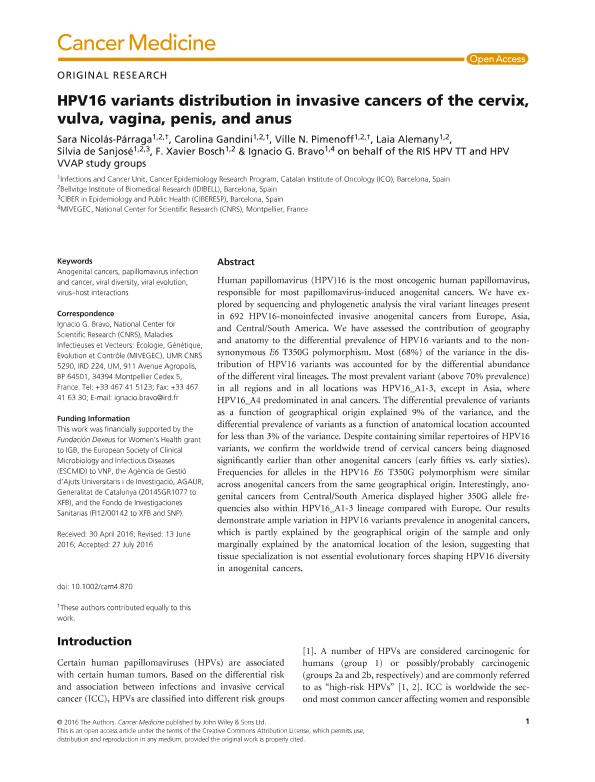Artículo
HPV16 variants distribution in invasive cancers of the cervix, vulva, vagina, penis, and anus
Nicolás Párraga, Sara; Gandini, Carolina Lia ; Pimenoff, Ville N.; Alemany, Laia; de Sanjosé, Silvia; Bosch, F. Xavier; Bravo, Ignacio G.
; Pimenoff, Ville N.; Alemany, Laia; de Sanjosé, Silvia; Bosch, F. Xavier; Bravo, Ignacio G.
 ; Pimenoff, Ville N.; Alemany, Laia; de Sanjosé, Silvia; Bosch, F. Xavier; Bravo, Ignacio G.
; Pimenoff, Ville N.; Alemany, Laia; de Sanjosé, Silvia; Bosch, F. Xavier; Bravo, Ignacio G.
Fecha de publicación:
10/2016
Editorial:
Wiley
Revista:
Cancer Medicine
ISSN:
2045-7634
Idioma:
Inglés
Tipo de recurso:
Artículo publicado
Clasificación temática:
Resumen
Human papillomavirus (HPV)16 is the most oncogenic human papillomavirus, responsible for most papillomavirus-inducedanogenital cancers. We have explored by sequencing and phylogenetic analysis the viral variant lineages presentin 692 HPV16-monoinfected invasive anogenital cancers from Europe, Asia,and Central/South America. We have assessed the contribution of geography and anatomy to the differential prevalence of HPV16 variants and to the nonsynonymous E6 T350G polymorphism. Most (68%) of the variance in the distributionof HPV16 variants was accounted for by the differential abundance of the different viral lineages. The most prevalent variant (above 70% prevalence) in all regions and in all locations was HPV16_A1-3,except in Asia, whereHPV16_A4 predominated in anal cancers. The differential prevalence of variants as a function of geographical origin explained 9% of the variance, and the differential prevalence of variants as a function of anatomical location accountedfor less than 3% of the variance. Despite containing similar repertoires of HPV16 variants, we confirm the worldwide trend of cervical cancers being diagnosed significantly earlier than other anogenital cancers (early fifties vs. early sixties).Frequencies for alleles in the HPV16 E6 T350G polymorphism were similar across anogenital cancers from the same geographical origin. Interestingly, anogenita lcancers from Central/South America displayed higher 350G allele frequencies also within HPV16_A1-3 lineage compared with Europe. Our results demonstrate ample variation in HPV16 variants prevalence in anogenital cancers, which is partly explained by the geographical origin of the sample and only marginally explained by the anatomical location of the lesion, suggesting that tissue specialization is not essential evolutionary forces shaping HPV16 diversity in anogenital cancers.
Archivos asociados
Licencia
Identificadores
Colecciones
Articulos(IBAM)
Articulos de INST.DE BIOLOGIA AGRICOLA DE MENDOZA
Articulos de INST.DE BIOLOGIA AGRICOLA DE MENDOZA
Citación
Nicolás Párraga, Sara; Gandini, Carolina Lia; Pimenoff, Ville N.; Alemany, Laia; de Sanjosé, Silvia; et al.; HPV16 variants distribution in invasive cancers of the cervix, vulva, vagina, penis, and anus; Wiley; Cancer Medicine; 5; 10; 10-2016; 2909-2919
Compartir
Altmétricas



